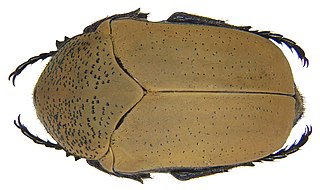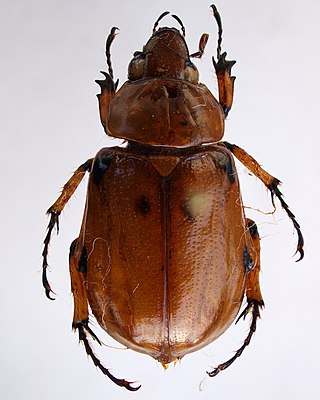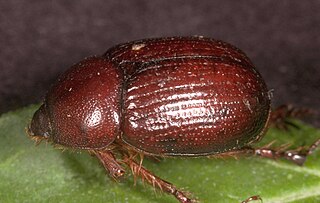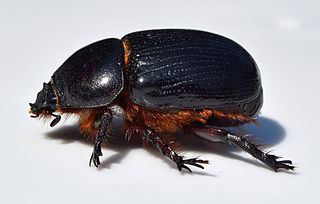
Dynastinae or rhinoceros beetles are a subfamily of the scarab beetle family (Scarabaeidae). Other common names – some for particular groups of rhinoceros beetles – include Hercules beetles, unicorn beetles or horn beetles. Over 1500 species and 225 genera of rhinoceros beetles are known.

Melolonthinae is a subfamily of the scarab beetles. It is a very diverse group; distributed over most of the world, it contains over 11,000 species in over 750 genera. Some authors include the scarab subfamilies Euchirinae and Pachypodinae as tribes in the Melolonthinae.

Oryctes is the most economically important genus of rhinoceros beetles in the subfamily Dynastinae, since it includes a notorious insect pest of palms.
Cyclocephala nodanotherwon is a species of rhinoceros beetle in the scarab family. It has only been found in Amazonas, Brazil. Brett C. Ratcliffe described and named the species in 1992.

Cyclocephalini is a tribe of scarab beetles in the family Scarabaeidae.

Hologymnetis is a genus of fruit and flower chafers in the family Scarabaeidae. There are about eight described species in the genus Hologymnetis.

Macrodactylus, known as rose chafers, are a genus in the family Scarabaeidae. There are at least 110 described species in Macrodactylus.
Hemiphileurus is a genus of rhinoceros beetles in the family Scarabaeidae. There are at least 60 described species in Hemiphileurus.
Hypotrichia is a genus of May beetles and junebugs in the family Scarabaeidae. There is at least one described species in Hypotrichia, H. spissipes.
Euetheola is a genus of rhinoceros beetles in the family Scarabaeidae. There are about seven described species in Euetheola.

Ancognatha is a genus of rhinoceros beetles in the family Scarabaeidae. There are more than 20 described species in Ancognatha.

Phileurus is a genus of rhinoceros beetles in the family Scarabaeidae. There are more than 20 described species in Phileurus.

Ligyrus gibbosus, the carrot beetle, is a species of rhinoceros beetle in the family Scarabaeidae. Adults are 13–17 mm (0.5–0.7 in) long, dark reddish-brown to black, and larvae are white with a dark head. It feeds on roots, grasses, and decaying vegetation in the soil, and is a pest of sunflowers and other crops.

Xyloryctes is a genus of rhinoceros beetles in the family Scarabaeidae. There are about 13 described species in Xyloryctes.

Dyscinetus is a genus of rice beetles in the family Scarabaeidae. There are more than 20 described species in Dyscinetus.

Archophileurus is a genus of rhinoceros beetles in the family Scarabaeidae. There are at least 30 described species in Archophileurus.
Gymnetina is a genus of fruit and flower chafers in the family of beetles known as Scarabaeidae. There are about six described species in Gymnetina.

Oryctini is a tribe of beetles in the Dynastinae.












